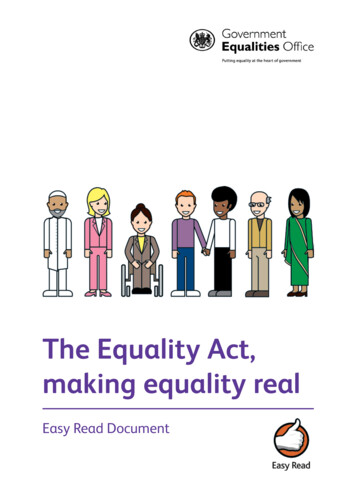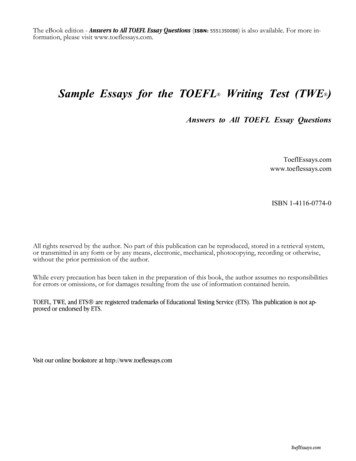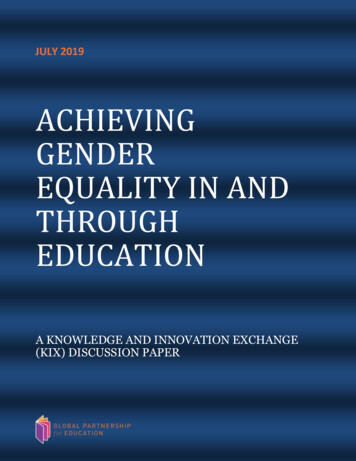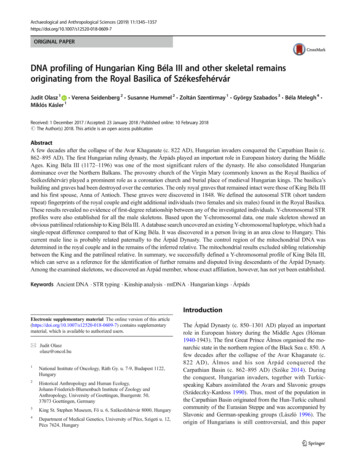
Transcription
Essays onEquality2019
Essays on EqualityEssays on EqualityForeword 4Julia GillardGender equality is everyone’s struggle – but also everyone’s gain 6Helen ClarkMost diversity and inclusion training is flawed. Here’s how to fix it10Rose CookMen outnumber women in leadership because we mistake confidence for competence14Tomas Chamorro-PremuzicNo Brexit deal can represent the “will of the people” without women in the negotiations18Emma KinlochBe like an orchestra: how to eliminate gender bias in venture capital funding22Iris Bohnet, Siri Chilazi, Anisha Asundi and Lili Gil VallettaThe future of work can be gender-equal – but technology is only part of the solution26Laura JonesWomen’s unpaid care work has been unmeasured and undervalued for too long30Diva DharThe “women’s vote” is a myth: the average voter is a female voter34Rosie CampbellWhat will it take for women to be equal at work in the UK?38Sam Smethers3
Essays on EqualityForewordJulia GillardFormer PrimeMinister of Australiaand Chair of theGlobal Institute forWomen’s LeadershipWelcome to this first edition of Essays on Equality, anew publication from the Global Institute for Women’sLeadership. Written by GIWL researchers, members of ourAdvisory Council and leading researchers and campaigners,this essay collection provides research-informed reflectionson the fight for women’s equality.Former Prime Minister of New Zealand Helen Clark, apatron of GIWL, kicks us off, writing on the importance offeminist leadership from men and women to help changemindsets, institutions and the law. She reminds us that we allgain from gender equality, so it is everyone’s responsibility.GIWL Senior Research Fellow Dr Rose Cook questionswhether the huge growth in diversity and inclusionactivities, and the millions invested in them, is actuallymaking a difference. She calls for an evidence-based andtargeted approach to D&I training, and highlights GIWL’supcoming executive education programme, which aims toaddress some of these challenges.GIWL Advisory Council member Professor TomasChamorro-Premuzic explains that by mistaking confidenceand charisma for competence, we end up with poorer leadersand fewer women at the top. He argues we need to valuedifferent characteristics if we are to improve leadershipquality and boost the number of female leaders.Emma Kinloch, GIWL Research and Projects Associate,tackles the thorny issue of Brexit, critiquing the ways inwhich women have been excluded or undermined duringthe UK’s negotiations for a deal with the EU. Given thisis one of the biggest challenges the UK has faced since theSecond World War, and the disproportionate way Brexit islikely to impact women, their voices must be heard in thisdebate.Another member of the GIWL Advisory Council, IrisBohnet, Professor of Business and Government andAcademic Dean of Harvard’s Kennedy School, contributes4
Essays on Equalitya piece with colleagues Siri Chilazi, Annisha Asundi and LiliGill Valletta on what the world of venture capital could learnfrom orchestra directors, who have combatted gender biasthrough blind recruitment processes.Laura Jones, GIWL Research Associate, looks at womenand the future of work, arguing that while new technologycan help address gender inequality in the workplace, morefundamental structural and cultural changes are needed tomake the world of work fairer.Taking a global look at gender inequality, Diva Dhar, SeniorProgramme Officer, Gender Data and Evidence, at theBill and Melinda Gates Foundation, writes on one of themost glaring manifestations of inequality between men andwomen: the gap in unpaid care work, which she argues mustbe better analysed and researched.Did you know that the average voter in the UK is a woman?Professor Rosie Campbell, GIWL Director, looks at women’spolicy preferences, how they vote, and whether Britain’spolitics is changing as, for the first time, female votersbecame more likely to vote Labour at the 2017 generalelection.Finally, Sam Smethers, Chief Executive of the FawcettSociety, one of the UK’s leading charities campaigning forwomen’s equality, rounds off our collection by highlightingpolicy changes that could drive real progress in improvingwomen’s working lives. Expanding gender pay gapreporting, equalising parental leave and mandating flexibleworking are just some of her suggestions.I hope you find these contributions enlightening andinformative. While they lay bare the challenges we face,they also offer hope, and crucially, practical solutions to helpcreate a fairer, more equal world. If you’d like to pick up anyof the themes here, or have any other thoughts, please do getin touch with the GIWL team: giwl@kcl.ac.uk.Julia Gillard5
Essays on EqualityGender equality is everyone’s struggle – butalso everyone’s gainHelen ClarkFormer PrimeMinister of NewZealand, formerhead of theUnited NationsDevelopmentProgramme, andmember of theGlobal Health 50/50Advisory CouncilThe struggle for women’s rights has been the subject of thewritten word for at least 500 years. Yet progress towardsequality is breathtakingly slow. The World Economic Forumestimates that it will take 202 years to achieve parity in theworkplace – measured in wages, seniority and participation.1Progress is hampered by entrenched social and culturalnorms that perpetuate discrimination against women, and bypockets of active resistance to gender equality that persist inmany countries, communities and families. Indeed, woventhrough the rise of authoritarian nationalism in diversecountries around the world is a common thread – an effort toroll back the rights of women.Nonetheless, the fight for gender equality appears to begaining momentum, spurred on not only by the rise of moreinterconnected generations of feminists (both women andmen) who argue against the immorality of inequality andmobilise around universal harms, such as violence againstwomen and sexual harassment, but also by an increasingbody of evidence showing that gender equality deliversmajor economic and social returns.Gender equality in the corporate workplace, for instance,brings financial benefits to companies. When boards aremore gender-equal, companies are more likely to be attunedto the attitudes and behaviours of whole populations, ratherthan of just one half of them. When women participateat a critical mass in politics, women’s perspectives arebetter reflected in legislation and decision-making, withmeasurable consequences on political agendas. Internationalevidence suggests that when there are significant numbersof women parliamentarians, issues previously unaddressedwill come to the fore – not least those dealing with access tohealthcare, education and other public services, pay equityand violence against women.Despite decades of struggle and empirical evidence on theshared benefits of gender equality, however, the march6
Essays on Equalitytowards equality faces deeply entrenched challenges. In2018 the New York Times Glass Ceiling Index found moreUS Republican senators and Democratic governors namedJohn (14 per cent and 19 per cent respectively) than thetotal number of women occupying these positions (12 percent and 13 per cent respectively).2 A similar story can betold of business leadership: the index noted that there wereas many men named James as women heading Fortune500 companies – 5 per cent in both cases. We need a fasterrate of change – ensuring that not only John, but also Jane,Jameela and Jasmin are equitably represented in theseseats of power and decision-making in every country andcommunity around the globe.How do we achieve faster progress towards gender equality,including at the level of leadership? How do we ensure that“We need to frame gender equality as a good that benefitseveryone in society. The fight for equality is a tide that liftsall boats”women have equitable opportunities to fulfil their potential– both inside and outside the workplace? We need tosignificantly shift the needle in three areas.First, we need to frame gender equality as a good thatbenefits everyone in society. The fight for equality is a tidethat lifts all boats. Redefining family-caring roles as sharedrather than the principal responsibility of women promoteswomen’s retention and progression in the workforce and,as evidence increasingly shows, contributes to improvedrelationships between fathers and their children, reducedrisk of divorce, improved outcomes for children and greaterfamily economic security.For too long the struggle for gender equality has polarisedpeople, created unnecessary divisions and fears, and mostdamagingly, been viewed as solely the responsibility7
Essays on Equalityof women. When a new gender equalityinitiative, Global Health 50/50, sent out a call“For too longfor volunteers, 60 people came forward – 59the struggle forof whom were women. The idea that it isgender equality haspredominantly the duty of women to furtherthe cause not only perpetuates the false ideapolarised people”that they alone reap the benefits, but also putsthe onus on women to challenge and changeentrenched power structures. By repositioninggender equality as an issue that benefits everyone, we candismiss the notion that one group’s equality comes at thecost of another. Gender equality is not a zero-sum game,but a shared responsibility for creating societies that workfor everyone.Second, we need workplaces that allow people to meettheir personal and family responsibilities without penalty.We need employers to demonstrate commitment tosupporting diversity – including gender diversity – andfoster environments that transcend traditional gendernorms that keep both men and women from realisingtheir potential. Creating conditions for fair and equitableworkplaces requires committed leadership, but employees,staff associations and unions have a role to play too. At aminimum, there should be robust policies and programmesthat ensure zero tolerance for sexual harassment, promoteflexible working hours, mandate paid parental leave andprovide support for caregivers.8
Essays on EqualityRecent data shows how far we are from this reality. In asector collectively committed to achieving gender equalityas a Sustainable Development Goal, global organisationsactive in health should be considered standard-bearers inpromoting gender-equitable workplaces. Yet in its reviewof 200 such organisations, Global Health 50/50 found thatonly 30 per cent reported having flexible work policies.Meanwhile, just a quarter of organisations publish theirsexual harassment policies – an important workplacetransparency measure overall.Third, we need to create structural change. Womencannot achieve equality in the workplace or in positionsof leadership unless they have comprehensive equalityin all aspects of their lives, underpinned by supportivelegal environments. A 2019 report by the World Bankreported that only six countries out of 187 gave womenand men equal rights in relation to laws affecting access toemployment and entrepreneurial activity.3 In some regions ofthe world, women had less than half the legal rights of men.To know whether our efforts are shifting the needle, wecan, of course, keep counting the Johns and Janes, butmore fundamentally we need rigorous and independentmonitoring systems and initiatives that hold policymakers,employers and workplaces to account. We need initiativeslike Global Health 50/50, which is showing how evidence,coupled with smart, political advocacy can shine a lighton inadequate gender equality practices and drive rapidorganisational change. We need more places to follow inthe steps of countries like Britain and Iceland in mandatinggender pay gap reporting. But gender equality is not simplyabout putting women in seats of powerthat have traditionally been held by men– it means rewiring power structures that“Gender equality is notdictate who can access opportunity andwho cannot, whether they be womena zero-sum game, butor any other underrepresented group.a shared responsibilityIn short, we need shifts in three areas –for creating societiesmindsets, institutions and the law. Thesethat work for everyone” can be driven by feminist leadership – fromboth women and men.9
Essays on EqualityMost diversity and inclusion training isflawed. Here’s how to fix itRose CookSenior ResearchFellow, GlobalInstitute for Women’sLeadershipIn recent years there has been a huge growth in the diversityand inclusion landscape. From 2014 to 2016 Google alonespent 265 million on programmes such as unconsciousbias training, and research suggests that 84 per cent oforganisations in the UK have a diversity strategy. Thatmight sound like cause for celebration. But there’s just oneproblem: there is little evidence that organisations haveactually become more diverse as a result.The proportion of women in senior business roles in theUK fell to 19 per cent in 2018, from a high of 21 per centin 2017. And over the last 15 years, that figure rose byjust one percentage point. Even in companies supposedlyconcerned with social justice, where diversity training iswidely used, senior staff are still overwhelmingly male andsome unsettling sexual harassment cases have stained thesupposedly forward-thinking veneer.4So why is the “diversity industrial complex”5 so lamentablyineffective at improving diversity in organisations? Manyof the reasons undoubtedly lie beyond the programmesthemselves, in deep-rooted cultural issues and the unequalgender division of unpaid labour globally. But let’s take alook at a typical D&I session. Many of us have experienceof these sessions, involving large numbers of people whohave no choice but to attend, comprising cringeworthy andpoorly conceived activities, led by well-meaning externalspeakers with little expertise in the research behind diversityand inclusion issues nor direct experience of making changein organisations.According to Katerina Bezrukova and colleagues, whoconducted a meta-analysis on the effectiveness of diversitytraining in 2016,6 it’s little wonder that these programmesare ineffective when many use negative messaging, focusingon identifying discriminatory behaviour or unconscioustendencies in participants. Programmes are not alwayssufficiently focused on behaviour change; their methodology10
Essays on Equalityis more suited to raisingawareness. In some cases,this will be preaching to theconverted; in others it couldbe perceived as coerciveor shaming and met withbacklash from those whomay feel there is too muchattention on diversity issues.“Diversity trainingshould be ongoing,integrated intoa wide range ofbusiness activities”Another factor inhibiting success is that diversity trainingoften consists of a large-scale, one-off, mandatory session.Evidence suggests that diversity training should be ongoing,integrated into a wide range of business activities andprocesses, while at the same time increasing contact amongdifferent groups of employees and fostering shared values.But these principles have made little headway into diversityprogrammes, which mainly continue to be one-off sessionsbased on an awareness-raising model.So far, so depressing. At the Global Institute for Women’sLeadership, we wanted to take a different approach todiversity training, informed by our knowledge of theevidence base and our principles as an institute. We’veput together an exciting programme that aims to improveworkplace diversity and inclusion by addressing every stageof the pipeline as individuals move through organisations:from how people are hired, how work is assigned andwhat happens during performance evaluations, to how11
Essays on Equalitycompensation is determined and how people obtainleadership positions.Instead of blanket-marketing to anyone who might beinterested or encouraging compulsory participation (as isoften the case with this type of training), we wanted totarget people who have the power to actually change thingsin their organisation and focus their minds on how to goabout it. Often, employees attending mandatory diversitytraining get on board with the content but have little powerto change the structural factors that led to diversity problemsin the first place, such as recruitment and promotionpractices, working-time policies, bullying and sexualharassment. Our hope is that those attending our courses“The key to solving the gender imbalance in leadership doesnot lie in ‘fixing women’”will have the power to develop evidence-based, tailoredstrategies to tackle these problems in their organisations.As an institute, we stress that the key to solving the genderimbalance in leadership does not lie in “fixing women” – forexample, making them more confident, increasing theirambition or encouraging them to “lean in”. As MichelleObama frankly put it: “That shit doesn’t work all the time.”7Moreover, these types of approaches imply that it is up towomen to fix diversity and inclusion in organisations. That’swhy the first theme of our executive education programmeis on changing processes – not people. We will show howorganisational processes can often be subtly biased againstwomen and minorities and how workplace norms canundermine even the most progressive initiatives. We willpresent the research evidence on biased recruitment andretention practices and consider what initiatives might“de-bias” them, drawing both on the research and on ourparticipants’ own unique expertise as agents of change intheir organisations.12
Essays on EqualityRather than focusing on what helps topromote women and minorities to positionsof power, we will consider the nature ofpower itself, challenging our participants’understandings of what leadership is.What traits and behaviours are associatedwith successful, profitable teams that alsohave high levels of job satisfaction andhealthy staff turnover? We will explorewhat the research says about what makesan effective leader, sharing some surprising insights revealingthat leadership is not all it seems and can be found inunlikely places.“The first theme of ourexecutive educationprogramme is onchanging processes –not people”Finally, our courses will turn to making the case for diverseand inclusive organisations. While there is a lot of evidenceon diversity-related problems in organisations, as wellas emerging evidence on solutions and the business casefor diversity, change won’t happen unless champions canconvince their organisations that it is necessary. We willuse case studies from businesses that have made significantprogress and build on participants’ own experiences ofpushing for equality to identify successful strategies formaking the case for change.While we know that training is only one piece of the puzzle,we hope that GIWL’s executive education programme candispel the idea that just throwing money at the problem willmake diversity concerns go away. We want to demonstratethat an evidence-based and targeted approach to trainingpeople on diversity and inclusion issues is the only real wayto accelerate the pace of change.For more informationabout GIWL’sexecutive educationprogramme, emailgiwl@kcl.ac.uk13
Essays on EqualityMen outnumber women in leadership becausewe mistake confidence for competenceTomas ChamorroPremuzicProfessor ofBusiness Psychology,University CollegeLondonLeadership, the process that enables individuals to worktogether in the pursuit of a common goal, has been a criticalresource throughout the evolution of humankind. Everysignificant accomplishment in human history – the use offire, the invention of writing, the mapping of the humangenome, and so on – sprang from collective action that couldnot have occurred without leadership.A century of science has provided an enormous amount ofevidence about what good and bad leadership looks like,but this does not erase the archetypes of leadership in ourminds. Our gut feeling for what constitutes good leadershipis shaped much more by our ancestral and evolutionary rootsthan by the latest research on leadership, as our brains havebeen shaped by millions of years of evolution. Even whenold models of leadership are no longer effective, they stillmatch our imaginary leadership archetypes fuelled by ourinstincts, and it is not easy to unlearn them.In my view, this is the main reason forthe uneven sex ratio in leadership and“Manifestations ofmanagement across the board, throughouthubris – often maskedcountries worldwide. And part of this is ouras charisma or charminability to discern between confidence andcompetence – that is, because we commonly– are commonlymisinterpret displays of confidence as amistaken forsign of competence. This is consistent withleadership potential”the finding that leaderless groups havea natural tendency to elect self-centred,overconfident and narcissistic individualsas leaders, and that these personality characteristics are notequally common in men and women.8 So, when it comes toleadership, the only advantage that men have over womenis the fact that manifestations of hubris – often masked ascharisma or charm – are commonly mistaken for leadershippotential.9 And again, these occur much more frequently inmen than in women.1014
Essays on EqualitySo long as we continue to associate leadership with“masculine” features, we can expect female leaders to beevaluated more negatively, even when their performance“This tendency to uphold typically male leadership stylesas more desirable is costing us, not just in terms of genderequality, but also in terms of lost revenue”is higher than that of their male counterparts, and evenwhen those who evaluate them are women.11 For instance,a recent study on social sensing, in which male and femaleleaders were tagged with sociometric badges that monitoredeverything they did and said for weeks, showed that despitea lack of behavioural or performance differences betweenmen and women, men were promoted to leadership rolesmuch more frequently than women were.12Yet this tendency to uphold typically male leadership stylesas more desirable is costing us, not just in terms of genderequality, but also in terms of lost revenue. There is nowcompelling scientific evidence for the notion that women are15
Essays on Equalitymore likely to adopt more effective leadership strategies thanmen. Most notably, in a comprehensive review of studies,Alice Eagly and colleagues showed that female managers aremore likely to elicit respect and pride from their followers,communicate their vision effectively, empower and mentorsubordinates, and approach problem-solving in a moreflexible and creative way, as well as fairly reward directreports.13 In contrast, male managers are statistically lesslikely to bond or connect with their subordinates and arerelatively more inept at rewarding them for their actualperformance.Indeed, whether in sports, politics or business, the bestleaders are usually humble14 – and whether through natureor nurture, humility is a much more common feature inwomen than men. For example, women outperform men onemotional intelligence, which is a strong driver of modestbehaviours. Furthermore, a quantitative review of genderdifferences in personality involving more than 23,000participants in 26 cultures indicated that women are moresensitive, considerate, and humble than men, which isarguably one of the least counterintuitive findings in thesocial sciences.15An even clearer picture emerges when one examines thedark side of personality16: for instance, our normativedata, which includes thousands of managers from acrossall industry sectors and 40 countries, shows that men areconsistently more arrogant, manipulative and risk-pronethan women. We also need to acknowledge the importanceof emotional intelligence – or EQ – which should be acore competency in any data-driven model of leadershippotential. Paying more attention to EQ would augmentboth the quality of leaders and the numberof female leaders, increasing the overall levelsof personal effectiveness, self-awareness andtransformational leadership in organisations.sports,“Whether inpolitics or business,the best leaders areusually humble”16So how do we fix this to not just increasethe representation of women in leadershipbut also improve the quality of our leadersoverall? As I argue in my latest book, Why do
Essays on Equality“Too many decision-makers overrate their intuition, andpolitical agendas interfere with the selection of talentedleaders”so many incompetent men become leaders (and how to fix it)?,organisations can take concrete steps. For example, theycan stop interpreting displays of overconfidence, narcissism,psychopathy, and charisma as a sign of leadership potential.In an ideal world, leaders would follow science-basedpractices and prioritise engaging with and inspiring theiremployees, and providing them with a sense of meaning andpurpose.So we need to properly understand leadership talent andlearn how to measure it. These solutions are easier said thandone. Too many decision-makers overrate their intuition,and political agendas interfere with the selection of talentedleaders, especially when the decision-makers are moreinterested in their own agendas than their organisation’swellbeing. Knowing how to detect true leadership potentialis clearly not enough. We also have to introduce measuresthat place better leaders in key roles and promote a culturethat helps them succeed.While it is certainly a sign of progress that a growing numberof organisations are putting in place deliberate interventionsto increase the proportion of women in leadership, a morereasonable goal would be to focus instead on selecting betterleaders, which would also take care of the gender imbalance.There is no conflict between boosting gender equality andboosting leadership quality. On the contrary, it is harder toimprove the standard of leadership without improving thenumber of female leaders.Adapted by permissionof Harvard BusinessReview Press. Excerptedfrom Why Do So ManyIncompetent MenBecome Leaders? (andHow to Fix It) by TomasChamorro-Premuzic.Copyright 2019 TomasChamorro-Premuzic. Allrights reserved.17
Essays on EqualityNo Brexit deal can represent the “will of thepeople” without women in the negotiationsThree years, two prime ministers, one big problem.Emma KinlochResearch andProjects Associate,Global Institute forWomen’s LeadershipIn the UK our politics has been dominated by one story andone story alone for the last three and a bit years: Brexit. Ithas led to total paralysis in the British political system. Withno consensus in parliament and Boris Johnson’s pledge totake the country out of the EU “do or die”, the prospect ofa no-deal Brexit is very real indeed. The deadlock faced byour political class is unprecedented in the post-war era.One solution to the impasse was suggested by the onlyGreen Party MP, Caroline Lucas. In August 2019 sheproposed an all-female “Emergency Cabinet” to block a nodeal Brexit. This suggestion drew derision, bemusement andcries of sexism from all sides of the political debate. Citingthe pivotal role Christiana Figueres and Ségolène Royalplayed in bringing about the Paris climate agreement, as wellas Betty Williams’ and Mairead Corrigan’s activism thatkickstarted the Peace People’s movement during the darkestdays of the Troubles in Northern Ireland, Lucas argued thatwomen do politics differently.17While there is some debate as to whether this is the case,there is a rich seam of feminist theory on the importance ofwomen’s presence in the political process.18 And the genderjustice argument cannot be overlooked: women make uphalf the population so should make up half of the voices inpolitical debate.As Lucas highlighted, this gap in women’s representationis never more apparent than in the Brexit process – andit has been since day one, when Theresa May appointedthree men to the positions of foreign secretary, internationaltrade secretary and Brexit secretary to carry out the UK’snegotiations with the EU.Now Boris Johnson’s “war cabinet”,19 a group of cabinetministers tasked with thrashing out Brexit, comprises18
Essays on EqualityChancellor of the Duchy of Lancaster Michael Gove,Chancellor of the Exchequer Sajid Javid, Brexit SecretaryStephen Barclay, Foreign Secretary Dominic Rabb andAttorney General Geoffrey Cox. Notice any similarities?The full cabinet has nine women members, so why notgive one a seat at the table? The most puzzling omission isHome Secretary Priti Patel – she holds one ofthe great offices of state, and you might thinkher input was a necessary addition, particularly“The full Cabinetgiven that, as the government itself hashas nine womenacknowledged, a no-deal Brexit risks causingcivil disobedience, undermining nationalmembers, so whysecurity and leading to increased immigrationnot give one a seatchecks.20at the table?”Boris Johnson isn’t the only one who has formwhen it comes to excluding women from thekey sources of power in British government. Just lookat his neighbour’s team at Number 11, the residence ofthe chancellor. Arguably the most powerful governmentdepartment, the Treasury is now run by an all-maleministerial team, led by Sajid Javid. Decisions made byTreasury officials in the event of a no-deal exit will behugely consequential to the future of the UK.The obvious counterargument to the charge that womenhave been silenced in this process is that our secondever female prime minister, Theresa May, was in chargeof Brexit for three years. The symbolic power of havinga woman in the highest political office of the nationcannot be denied, yet within months of taking office Maywas subject to the usual slurs often directed at femalepoliticians. The “Maybot” cartoon,21 a caricature of anunfeeling robot with no capacity for empathy, took on a lifeof its own, illustrating the age-old double bind for femaleleaders that you are either too sweet to lead or to shrill (orrobotic in this case) to like.22The seeds of the Maybot nickname were sown duringMay’s leadership election, when she w
The "women's vote" is a myth: the average voter 34 is a female voter Rosie Campbell What will it take for women to be equal at 38 work in the UK? Sam Smethers Essays on Equality . and charisma for competence, we end up with poorer leaders and fewer women at the top. He argues we need to value










